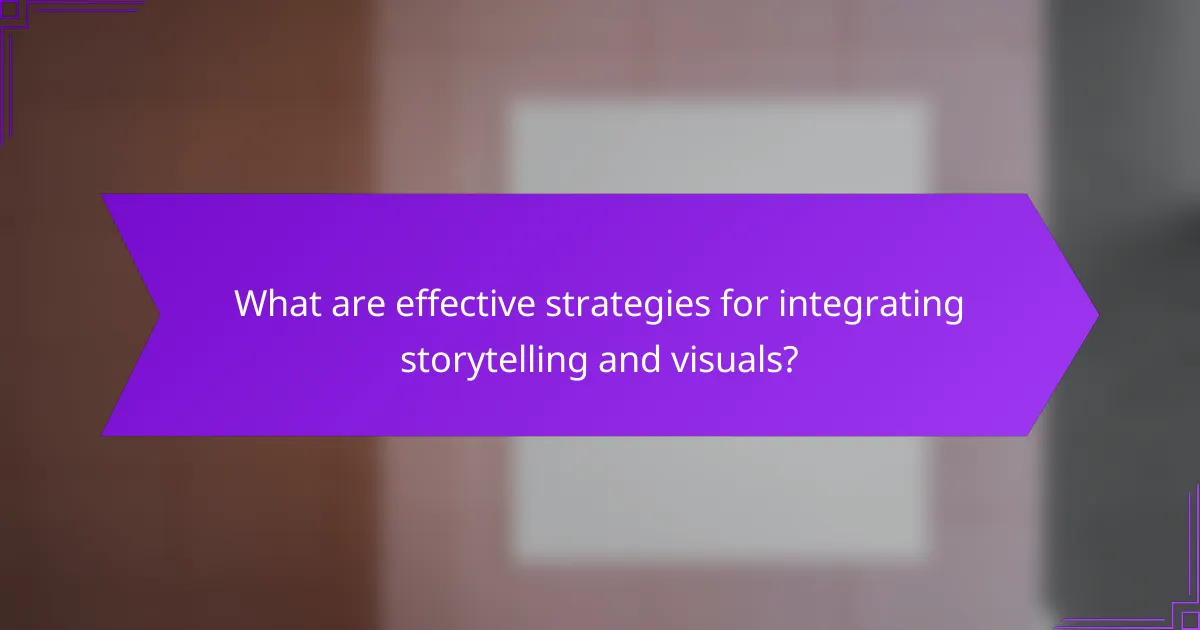Content marketing thrives on the synergy of storytelling, visuals, and SEO, each playing a vital role in engaging audiences. Storytelling creates relatable narratives that foster brand loyalty, while visuals enhance understanding and shareability. Meanwhile, effective SEO strategies ensure that content reaches its intended audience by improving visibility and user experience. Together, these elements form a powerful approach to capturing attention and driving meaningful interactions.

How does storytelling enhance content marketing?
Storytelling enhances content marketing by creating a narrative that resonates with the audience, making the content more relatable and memorable. This approach fosters a deeper connection between the brand and its consumers, ultimately driving engagement and loyalty.
Emotional connection with audience
Storytelling allows brands to evoke emotions, which can significantly strengthen the bond with their audience. By sharing relatable experiences or challenges, brands can create empathy and trust, making consumers feel understood and valued.
For example, a brand sharing a customer’s success story can humanize its products or services, making them more appealing. This emotional connection often leads to increased customer loyalty and advocacy.
Improved brand recall
Stories are easier to remember than facts or figures, which enhances brand recall. When consumers engage with a compelling narrative, they are more likely to retain the associated brand information long after the initial interaction.
Using vivid imagery and relatable characters in storytelling can help embed the brand in the audience’s memory. Brands that effectively weave their identity into a story can see a significant boost in recognition and recall during purchasing decisions.
Increased engagement rates
Content that tells a story tends to generate higher engagement rates across various platforms. Audiences are more likely to share, comment on, or react to content that resonates with them emotionally, leading to broader reach and visibility.
To maximize engagement, brands should focus on creating narratives that encourage interaction, such as asking questions or inviting feedback. This approach not only boosts engagement but also fosters a community around the brand, enhancing customer relationships.

What role do visuals play in content marketing?
Visuals are crucial in content marketing as they enhance engagement, improve understanding, and increase shareability. Effective use of images, infographics, and videos can significantly boost the impact of your content.
Enhanced comprehension of information
Visuals help break down complex information, making it easier for audiences to grasp key concepts quickly. For instance, infographics can simplify data-heavy content, allowing viewers to absorb information at a glance.
Consider using charts or diagrams to illustrate trends or processes. This approach can reduce cognitive load and enhance retention, as people often remember visual information better than text alone.
Higher social media shares
Content that includes visuals tends to receive more shares on social media platforms. Posts with images are known to generate significantly higher engagement rates compared to text-only posts.
To maximize shares, ensure your visuals are eye-catching and relevant to your content. Using compelling images or short videos can encourage users to share your posts, expanding your reach and visibility.
Stronger brand identity
Consistent use of visuals can reinforce your brand identity and make your content more recognizable. Incorporating brand colors, logos, and specific styles in your visuals helps create a cohesive look across all marketing materials.
For example, using a specific color palette or graphic style can help your audience associate those visuals with your brand. This recognition can foster trust and loyalty over time, making your content more impactful.

How can SEO optimize content marketing efforts?
SEO enhances content marketing by improving visibility in search engine results, attracting more relevant traffic, and fostering a better user experience. By integrating targeted keywords and optimizing site structure, businesses can effectively reach their audience and achieve marketing goals.
Improved organic search visibility
SEO boosts organic search visibility by ensuring that content is easily discoverable by search engines. This involves using relevant keywords, optimizing meta tags, and creating high-quality backlinks. For instance, a blog post that targets specific keywords related to a niche can rank higher, making it more likely to be seen by potential customers.
To maximize visibility, regularly update content and ensure it aligns with current search trends. Tools like Google Analytics can help identify which keywords are driving traffic, allowing for ongoing optimization.
Higher website traffic
Effective SEO strategies lead to increased website traffic by attracting users actively searching for related information. By focusing on long-tail keywords and creating engaging content, businesses can draw in a targeted audience. For example, a website that ranks for niche keywords may see traffic increases of 20-50% over time.
Utilizing social media and email marketing to promote optimized content can further enhance traffic. Regularly analyzing traffic sources helps identify successful strategies and areas for improvement.
Better user experience
SEO contributes to a better user experience by ensuring that websites load quickly, are mobile-friendly, and provide relevant content. A well-structured site with clear navigation helps users find information easily, reducing bounce rates. For instance, pages that load in under three seconds typically retain more visitors.
Incorporating visual elements like images and videos can also enhance engagement. Ensuring that all content is accessible and meets usability standards can significantly improve user satisfaction and retention.

What are effective strategies for integrating storytelling and visuals?
Effective strategies for integrating storytelling and visuals involve combining narrative elements with engaging graphics to enhance audience understanding and retention. This approach can significantly improve content impact by making complex information more accessible and memorable.
Use of infographics
Infographics are powerful tools for storytelling as they visually represent data and concepts, making them easier to digest. When creating infographics, focus on clarity and relevance; ensure that the visuals directly support the narrative you wish to convey.
Consider using a mix of charts, icons, and concise text to illustrate key points. For example, a marketing report might use an infographic to show trends over time, highlighting significant changes in consumer behavior with visual cues.
Video storytelling techniques
Video storytelling techniques can captivate audiences by combining visuals, sound, and narrative. Start with a strong hook to grab attention, followed by a clear storyline that guides viewers through the content.
Utilize elements like interviews, animations, and on-screen text to enhance understanding. For instance, a brand might create a short video that tells the story of its founding, using archival footage and customer testimonials to build emotional connections.
Case studies with visual elements
Incorporating visual elements into case studies can make them more engaging and informative. Use images, graphs, and charts to illustrate results and processes, helping readers visualize the impact of your solutions.
When presenting a case study, structure it with a clear narrative arc: outline the challenge, describe the solution, and showcase the results with visuals. This format not only informs but also persuades potential clients by demonstrating real-world applications of your offerings.

How to measure the success of content marketing campaigns?
Measuring the success of content marketing campaigns involves analyzing various metrics that reflect performance and audience engagement. Key indicators include traffic, engagement rates, and conversions, which help determine the effectiveness of your content strategy.
Key performance indicators (KPIs)
Key performance indicators (KPIs) are essential for tracking the success of content marketing efforts. Common KPIs include website traffic, bounce rates, and average session duration. These metrics provide insights into how well your content attracts and retains visitors.
To effectively measure KPIs, set specific goals for each campaign. For example, aim for a certain percentage increase in traffic or a reduction in bounce rates over a defined period. Regularly reviewing these metrics helps in adjusting strategies as needed.
Audience feedback and engagement metrics
Audience feedback and engagement metrics are crucial for understanding how your content resonates with your target audience. Metrics such as comments, shares, and likes on social media platforms indicate how well your content engages viewers.
Consider utilizing surveys or polls to gather direct feedback from your audience. This qualitative data can complement quantitative metrics, providing a fuller picture of audience sentiment and preferences.
Conversion rates analysis
Conversion rates analysis focuses on the percentage of visitors who take a desired action, such as signing up for a newsletter or making a purchase. This metric is vital for assessing the effectiveness of your content in driving business goals.
To improve conversion rates, analyze the user journey and identify potential drop-off points. A/B testing different content formats or calls to action can help determine what resonates best with your audience, leading to higher conversion rates over time.

What are the prerequisites for successful content marketing?
Successful content marketing requires a deep understanding of your target audience and clear brand messaging. These foundational elements help ensure that your content resonates with potential customers and effectively communicates your brand’s value.
Understanding target audience
Knowing your target audience is crucial for crafting content that engages and converts. Start by creating detailed buyer personas that outline demographics, preferences, and pain points. This will help tailor your messaging to meet their specific needs.
Consider conducting surveys or interviews to gather insights directly from your audience. Analyze engagement metrics from previous content to identify what resonates most with them. This data-driven approach can significantly enhance your content strategy.
Clear brand messaging
Clear brand messaging ensures that your audience understands who you are and what you stand for. Define your brand’s mission, vision, and values, and ensure these elements are consistently reflected in your content. This builds trust and loyalty among your audience.
Use simple, concise language that aligns with your audience’s understanding. Avoid jargon unless it is commonly accepted in your industry. Regularly review and refine your messaging to adapt to changing market conditions or audience preferences.



